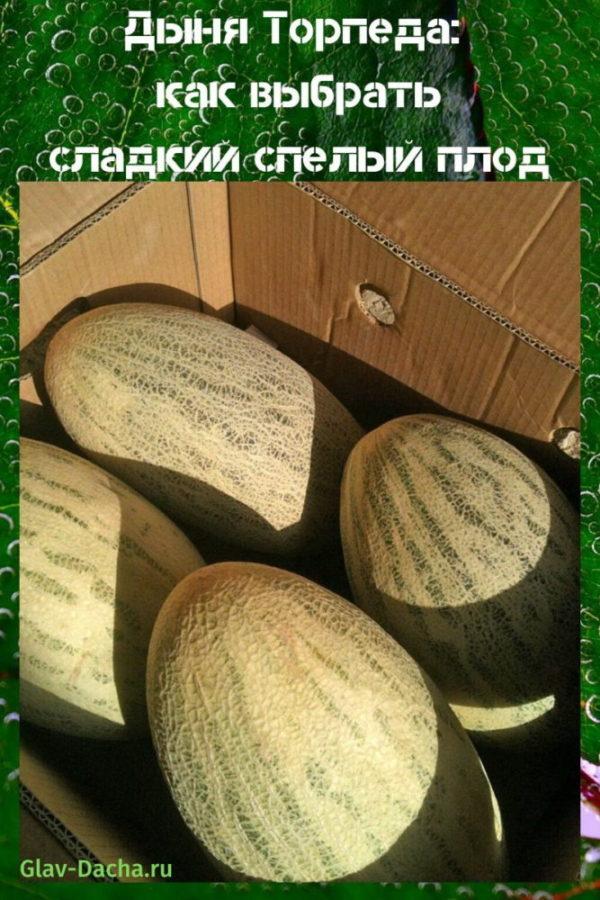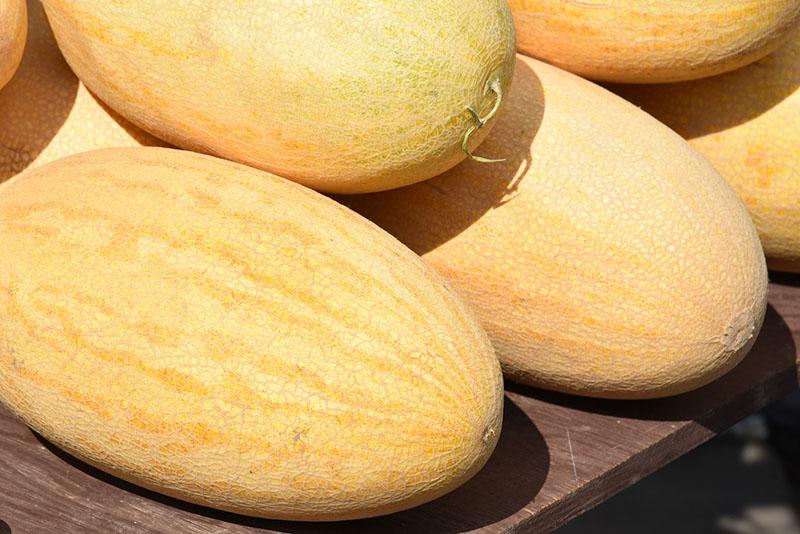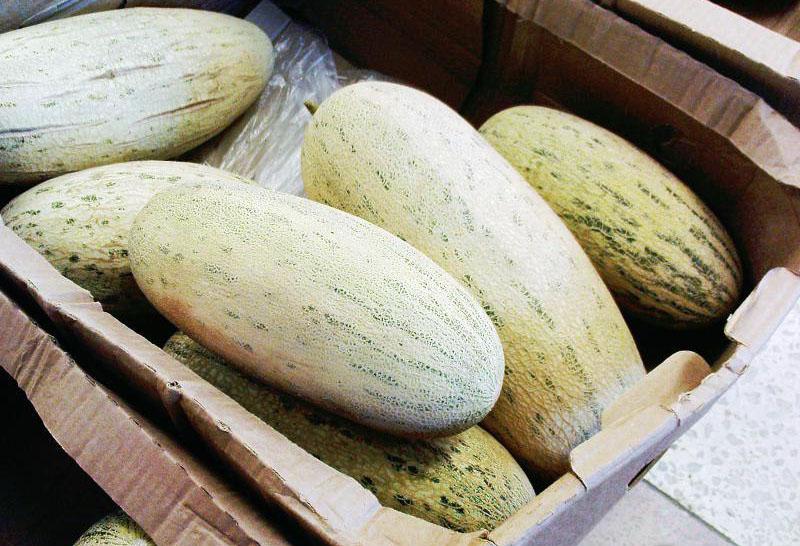Melon Torpedo: How to Choose a Sweet Ripe Fruit
 Large-fruited, late-ripening melons and gourds are poorly adapted for growing in most of Russia. One of the most popular is the torpedo melon, how to choose it correctly is especially important to know - the product comes to the shelves mainly from Uzbekistan. Spoiled or tasteless, plucked green fruits can reach the consumer.
Large-fruited, late-ripening melons and gourds are poorly adapted for growing in most of Russia. One of the most popular is the torpedo melon, how to choose it correctly is especially important to know - the product comes to the shelves mainly from Uzbekistan. Spoiled or tasteless, plucked green fruits can reach the consumer.
Variety characteristics

Torpedo is a late-ripening variety. In Central Asia, it ripens no earlier than in the second decade of August, the fruit reaches 7-9 kg, under especially favorable conditions - up to 10-15 kg. For Russia, outdoor cultivation is impossible - you need a greenhouse, 90 days. But to get a melon exceeding 5 kg is unlikely to work, it will be less sweet and juicy than ripe in Uzbekistan.
 The ripe fruit of the Torpedo is light yellow, the rind is dense, covered with a pattern-like network of cracks. The shape is oblong, with rounded ends, the length can reach half a meter or more. The pulp is tender, white, with a high sugar content and a pleasant characteristic aroma, somewhat oily.
The ripe fruit of the Torpedo is light yellow, the rind is dense, covered with a pattern-like network of cracks. The shape is oblong, with rounded ends, the length can reach half a meter or more. The pulp is tender, white, with a high sugar content and a pleasant characteristic aroma, somewhat oily.
The torpedo is more juicy than other popular varieties of melon - Kolkhoznitsa, Thai, Gulyabi.
Nutritional value and medicinal properties
 For torpedo melon, how to choose a good fruit is also of great importance because it is the quality that determines the maximum content of nutrients. The nutritional value of 100 g of the product is about 35.7 kcal (this is more than other varieties).
For torpedo melon, how to choose a good fruit is also of great importance because it is the quality that determines the maximum content of nutrients. The nutritional value of 100 g of the product is about 35.7 kcal (this is more than other varieties).
In percentage terms, melon consists of:
- water - 90;
- dietary fiber - 0.9;
- carbohydrates - 7.4;
- proteins - 0.6;
- fats - 0.3.
 The remaining 0.2% is accounted for by nutrients - vitamins and minerals useful for the body. There are easily digestible carbohydrates, saturated fatty acids, Omega-3, enzymes, pectins in the melon.
The remaining 0.2% is accounted for by nutrients - vitamins and minerals useful for the body. There are easily digestible carbohydrates, saturated fatty acids, Omega-3, enzymes, pectins in the melon.
Especially a lot:
- ascorbic acid;
- beta carotene;
- vitamins A, K, PP, group B;
- silicon;
- cobalt;
- potassium;
- gland;
- copper;
- magnesium;
- sodium;
- chrome.
Ripe melon is easy to digest, thirst quencher and delicious. Besides:
- improves bowel function;
- is an antioxidant;
- has diuretic properties;
- has a beneficial effect on blood vessels and heart;
- helps to maintain visual acuity;
- strengthens the immune system;
- increases hemoglobin;
- promotes the production of serotonin;
- seeds are a powerful aphrodisiac.
Melon is eaten fresh, dried, dried, used for making desserts, melon honey, candied fruits. When processed, the calorie content increases.
Melon Torpedo: how to choose tasty and sweet
 Of course, you can make candied fruit or dessert from green melon. But did they buy it for this? While most Russians know how to choose sweet watermelons, not everyone understands melons. In fact, there is nothing difficult in determining a quality fruit.
Of course, you can make candied fruit or dessert from green melon. But did they buy it for this? While most Russians know how to choose sweet watermelons, not everyone understands melons. In fact, there is nothing difficult in determining a quality fruit.
When and where to buy

For melons, including torpedo melons, "how to choose" is an important question, but the time and place of purchase is equally important:
- It is highly likely that the first fruits contain a lot of nitrates. Melon Torpedo is late, in Central Asia it ripens by mid-August.In Russia, the sun is less, but the fruits will not be as large as in Uzbekistan, which means that they need less time to get sweets. In any case, buying a Torpedo in July or before mid-August is a risky business. Instead of pleasure, you can get poisoned. It is best to focus on the beginning of September.
- You cannot take melons on the track. Melons there definitely did not pass the Rospotrebnadzor test for the presence of nitrates and other harmful substances. And they probably absorbed dust, toxins from the exhaust gases of passing cars.
Appearance
 The rind of a high-quality torpedo melon is rough, elastic, covered with a white mesh of grooves, light or pale yellow, often with longitudinal intermittent stripes of a darker shade. The color should be uniform. A single whitish spot is allowed - the fruit was lying on the ground, in this place the color will be lighter. The presence of such a mark often indicates that the melon was grown without "lethal" doses of chemistry and ripened on its own.
The rind of a high-quality torpedo melon is rough, elastic, covered with a white mesh of grooves, light or pale yellow, often with longitudinal intermittent stripes of a darker shade. The color should be uniform. A single whitish spot is allowed - the fruit was lying on the ground, in this place the color will be lighter. The presence of such a mark often indicates that the melon was grown without "lethal" doses of chemistry and ripened on its own.
Good fruit:
- heavy;
- with a dry thick tail;
- the nose is soft;
- the skin is easy to scratch;
- when pressed, the fruit is a little springy, but no marks remain;
- seeds are yellowish, easily separated from the pulp.
The fact that the melon is green can be recognized by the following signs:
- the rind is smooth and firm;
- the fruit is slightly shiny;
- the nose (the place where the flower is attached) does not bend;
- fresh tail;
- after cutting, a green strip is visible under the skin.
Overripe melon:
- after pressing, a dent remains on the side;
- the surface is dotted with pits;
- there are spots on the skin;
- pulp with a bitter taste.
Signs of nitrate abuse during cultivation:
- the grooves are not white, but green;
- when cut, a yellow strip is found under the skin;
- bright yellow integumentary color.
Aroma and sound
 The torpedo is less fragrant than the Kolkhoz Woman. But on a hot day, the smell of a few melons should be heard several meters away. It is believed that the sweet ripe torpedo smells flower honey, pear and vanilla.
The torpedo is less fragrant than the Kolkhoz Woman. But on a hot day, the smell of a few melons should be heard several meters away. It is believed that the sweet ripe torpedo smells flower honey, pear and vanilla.
If the melon has an unpleasant aroma, it is most likely spoiled. The smell of grass signals that the taste will be the same - Torpedo is green.
If you pat a ripe melon, it will make a dull sound. A sonorous one, such as that of a well-ripened watermelon, signals that the fruit is green.
You cannot buy a cut melon Torpedo!
How to eat melon
 Melon is a separate dish. It cannot be eaten on an empty stomach. At least 2 hours should pass from the main meal, after - at least 30 minutes. When combined with other foods, the melon will ferment in the stomach, possibly bloating and gas.
Melon is a separate dish. It cannot be eaten on an empty stomach. At least 2 hours should pass from the main meal, after - at least 30 minutes. When combined with other foods, the melon will ferment in the stomach, possibly bloating and gas.
A particularly unfortunate idea is to combine the melon with alcohol, wash it down with cold water or milk. This can cause poisoning.
Before use, the fruit must be washed with soap and wiped dry. Use only a clean knife.




If, after cutting, dark spots are found on the pulp, it is better to discard the melon whole. It is flawed. Removing the affected areas will not help - any piece can be poisoned.
Melon Torpedo is delicious, sweet, with a unique aroma. But the best fruits come to the counters from Central Asia, in order not to get green or spoiled, you need to choose the right one.